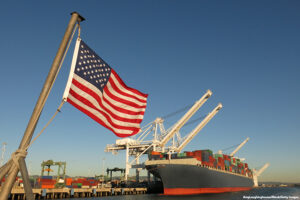
Nearly 50,000 members of the International Longshoremen’s Association (ILA) reached an agreement to end their strike on Friday, October 4, 2024. These union members are dockworkers at the cargo ports on the nation’s East Coast and Gulf Coast. The United States Maritime Alliance (USMX) which represents ocean shipping companies and port operators offered 62 percent raises.
The agreement also extended the current dockworkers’ contract until January 15, 2025, allowing time to resolve other contract issues.
Shipping and the Economy
The strike began on Tuesday, October 1, though the ILA and the USMX had been in negotiations for months prior to the strike. The quick agreement by the two sides helped avoid an enormous economic impact that the strike could have had. Each day, more than $2 billion in goods are handled in ports along the East Coast and Gulf Coast. About a million shipping containers are delivered to those ports each month.
Because they were worried about the possible economic disruptions, trade groups sent a letter to President Biden warning of potential negative economic effects of a long-term strike.
How the Supply Chain Works

Port workers handle goods exported from the United States and shipped overseas and imported goods from other countries. The imported goods are unloaded from shipping containers for distribution around the United States. Imported goods could include food items including bananas and sugar, or clothing, furniture, cars, farm machinery, and manufacturing equipment. An extended workers’ strike could have slowed or halted the unloading of these goods and resulted in shortages of many goods across the country. Shortages would have then led to price hikes for consumers.
Retailers in the United States were also concerned about having enough inventory for the holiday shopping season. Many retail businesses attempted to get products delivered before the October 1st strike deadline.
During the strike, ships arriving at East Coast and Gulf Coast ports had to sit and wait until workers returned. If the strike had continued, perishable goods like food products could have spoiled.
The Wage and Profit Gap
The ILA was seeking a 77 percent wage increase over 6 years, which would have been a $5 per hour increase each year for 6 years. The union said that the demands were reasonable based on record profits made by the shipping industry during the pandemic. USMX first offered a 50 percent pay increase, which the union rejected. The last contract in 2018 gave workers a $1 per hour increase for 4 of 6 years.
In addition to wage increases, the ILA still wants a ban on automation or semi-automation at the ports as automation could mean a loss of union members’ jobs. .
The strike affected more than a dozen ports, including the ports of:
- Boston, Massachusetts;
- the New York/New Jersey port;
- Philadelphia, Pennsylvania;
- Baltimore, Maryland;
- Norfolk, Virginia;
- Wilmington, North Carolina;
- Charleston, South Carolina;
- Savannah, Georgia;
- Jacksonville, Miami, and Tampa, Florida ports;
- Mobile, Alabama:
- New Orleans, Louisiana; and
- Houston, Texas.
